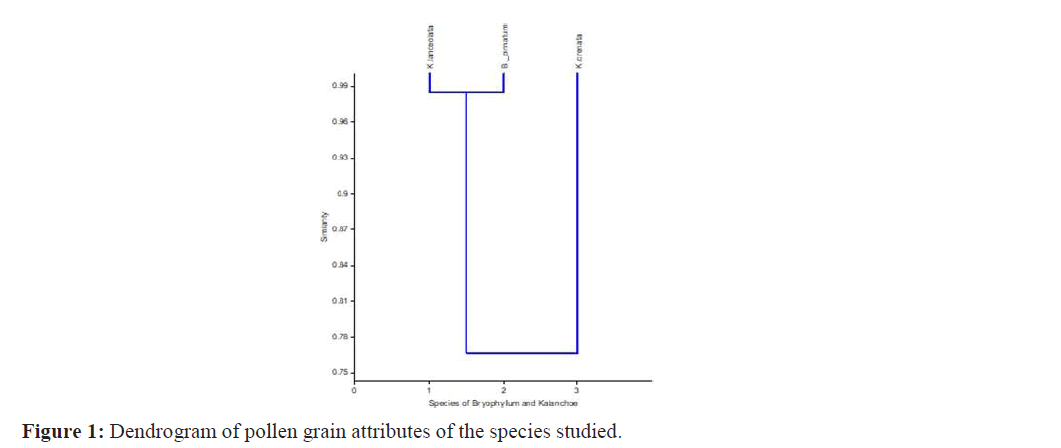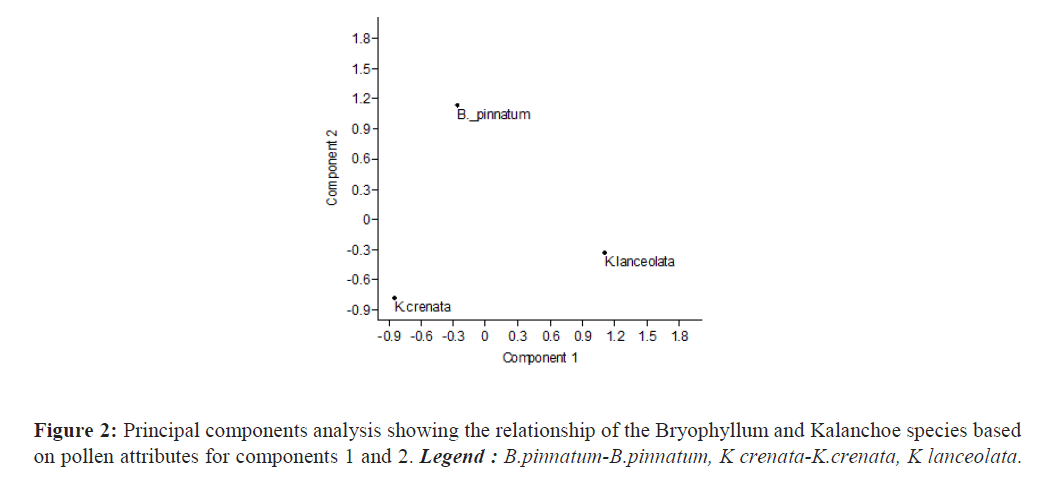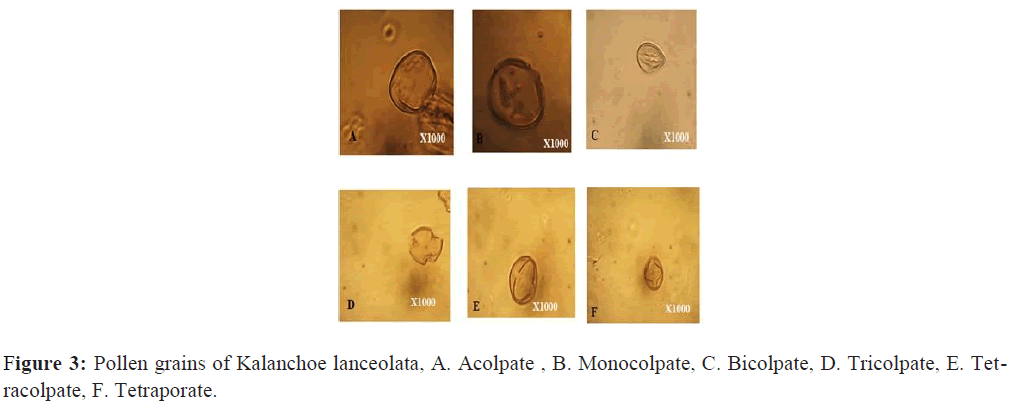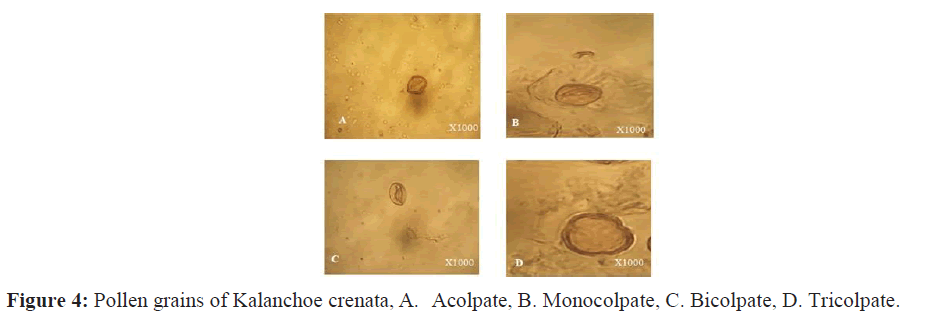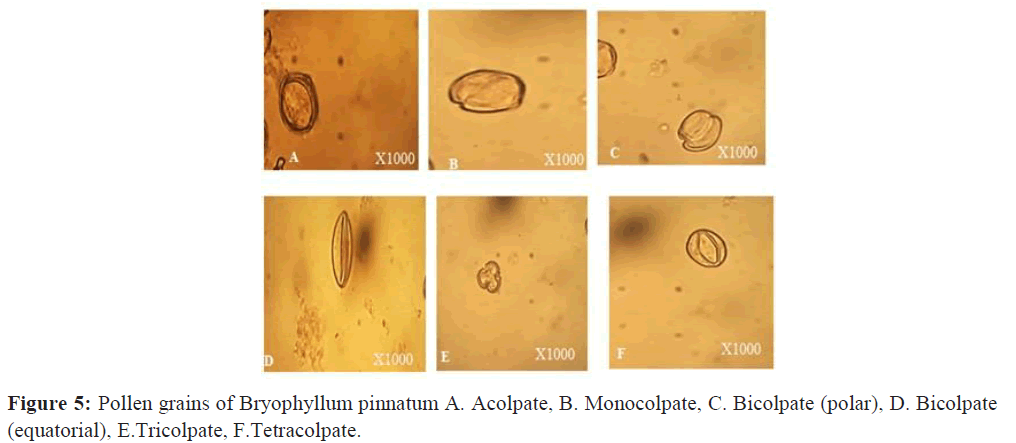ISSN : 2249 - 7412
Asian Journal of Plant Science & Research
Pollen Morphology of Some Species of Genera Kalanchoe and Bryophyllum in the Subfamily Kalanchoideae in South Western Nigeria
Tolulope Mary Olutayo* and Oluwabunmi Okerinmola Arogundade
Department of Botany, Obafemi Awolowo University, Osun, Nigeria.
- *Corresponding Author:
- Tolulope Mary Olutayo
Department of Botany,
Obafemi Awolowo University, Osun,
Nigeria,
E-mail: olutayotolulope42@gmail.com
Received date: August 01, 2022, Manuscript No. AJPSKY-22-13951; Editor Assigned date: August 03, 2022, PreQC No. AJPSKY-22-13951(PQ); Reviewed date: August 15, 2022, QC No. AJPSKY-22-13951; Revised date: August 24, 2022, Manuscript No. AJPSKY-22-13951(R); Published date: August 31, 2022, DOI: 10.36648/2249- 7412.12.8.305
Citation: Olutayo TM, Arogundade OO (2022) Pollen Morphology of Some Species of Genera Kalanchoe and Bryophyllum in the Subfamily Kalanchoideae in South Western Nigeria. Asian J Plant Sci Res Vol.12 No.8:305.
Abstract
Acetolysed pollen grains of three species in the genera Bryophyllum and Kalanchoe were examined with the aim of studying the pollen characters that are of taxonomic importance among them. The three species belong to subfamily Kalanchoideae. The acetolysis procedure was carried out following standard procedures and the pollen characters were described and measured. The three species used are Bryophyllum pinnatum (Lam.) Oken, Kalanchoe crenata (Andr.) Haw and Kalanchoe lanceolata (Forsk.) Pers. Psilate sculpturing was observed in all the species studied. Pollen grains ranging from acolpate, monocolpate, bicolpate and tricolpate were found in all of the species investigated. Circular pollen shape was found in all of the studied species. Palynological informations about the pollen grain of the two genera were revealed.
Keywords
Aperture; Sculpturing; Pollen shape; Pollen diameter; Pore diameter
Introduction
Crassulaceae comes as the third largest succulent plant family following Aizoaceae and Cactaceae with 1,500 species from 35 genera [1,2]. Members of Crassulaceae are mostly found in arid and/or rocky habitats even though they prefer warm region while they are rarely found in aquatic environment. It was affirmed by, that the family Crassulaceae is subdivided into three subfamilies namely Crassuloideae, Kalanchoideae and Sempervivoideae. Genera Kalanchoe Adans and Bryophyllum Salisb. Belong to the the subfamily Kalanchoideae [3,4].
Pollen morphology of Crassulaceeae has been studied by [5-7]. Pollens of 20 species of Korean Sedum were investigated by under the scanning electron microscope to look for new features for classifying sedum species located in Korea. Pollens of Rosularia cypria, Rosularia pallidiflora and sedum lampusae amongst other species native to north- ern cyprus under the light and Scanning Electron Microscope (SEM) were studied by [8,9]. Palynological evidence alongside morphological evidence was used by [10] to determine the taxonomic status of Rosularia globulariifolia and Rosularia pallidiflora in the subfamily sempervivoideae. Kalanchoe, sedum and Rosularia was mentioned as one of the genera in the family Crassulaceae by [3]. Pollen morphology/palynology can be used to support morphology of plants and as an important tool for contemporary taxonomist for the delimitation of species [11]. Pollen morphological characters have been found valuable and helpful in delimiting the taxa of Crassulaceae [12]. There is lack of published work on the pollen morphology of members of genera Bryophllyum and Kalanchoe espe- cially the species found growing in Nigeria. Hence the study.
Materials and Methods
Pollens were collected from flowers of two species of Kalanchoe, Kalanchoe crenata (Andr.) Haw and Kalanchoe lanceolata (Forsk.) Pers and Bryophyllum pinnatum (Lam.) Oken and stored in 100% ethanol. The acetolysis includes a number of centrifugation at 4000 rpm for 20 minutes at each stage. The pollens were first macerated in the centrifuge tubes containing absolute ethanol with a stiring rod. The specimens were then centrifuged at the above mentioned speed and minute. The alcohol was poured off, 5 ml of glacial acetic acid was added to each tube and the mixture was centrifuged again at the same speed and time. The glacial acetic acid was poured off and acetolysis mixture (1 ml of H2SO4 in 6 ml acetic anhydride) was added, the tubes containing the mixture was then placed in a water bath at 70Ë?C and heated to boil while the mixture was stirred at intervals. The boiled mixture was then centrifuged again at the same speed and minute. Afterwards, 10 ml of glacial acetic acid was added, centrifuged again at the same speed and minute and was later poured off. Distilled water was finally added, the mixture shaken and centrifuged at the same speed. The water was poured off and the pollen grains were mounted in dilute glycerine for observation under the microscope as shown in Figure 1.
Photomicrographs of the acetolysed pollen grains were taken using ACCU-scope trinocular microscope(ACCU- scope 33001 led trinocular microscope with 3.2 MP CMOS digital camera). Qualitative characters such as exine pattern, type of aperture, type of pollen and shape of the pollen grains were observed. Quantitative characters that were measured or counted were pollen wall thickness, pollen diameter, depth of colpi, distance between colpi, pore diameter and number of pores. Data gotten were subjected to Single Linkage Cluster Analysis (SLCA), Principal Components Analysis (PCA) using Paleontological Statistics Software Package (PSSP) and Least Significant Difference Test (LSDT) given by Figure 2.
Results
The pollen grains of these species are majorly circular to oval in shape. The two types of aperture, colpi (furrow) and pores are present in the pollen grains. The pollens are light brown in colour with psilate sculpture. Table 1 shows the qualitative characters of the pollen grains. Table 2 shows the least significant difference test of the species of Kalan- choe and Bryophyllum studied. Table 3 shows Eigenvalue and the percentage of total variation accounted for by the first two components axes of ordination of the Bryophyllum and Kalanchoe.
| Species | Shapes | Pollen types | Sculpturing |
|---|---|---|---|
| B. pinnatum | Circular and Oval | Acolpate, monocolpate, bicolpate, tricolpate, tetracolpate | Psilate |
| K. lanceolata | Circular and Elliptic | Acolpate, monocolpate, bicolpate, tricolp ate, tetraporate and tetracolpate |
Psilate |
| K. crenata | Oval and Circular | Acolpate, Monocolpate, Bicolpate, and Tricolpate | Psilate |
Table 1: Summary of the qualitative characters of the pollen grains.
| Species | Pollen diameter | Pollen wall thickness | Depth of colpi | Distance between colpi | Pore diameter | No of pores |
|---|---|---|---|---|---|---|
| K. crenata | 17.70b | 1.94b | 12.77a | 7.07c | 1.33c | 0.38b |
| K. lanceolata | 27.28a | 1.98b | 6.33b | 15.13a | 10.75a | 3.30a |
| B. pinnatum | 16.97c | 2.24a | 5.13b | 10.08b | 5.87b | 2.70a |
Table 2: The mean values of the quantitative palynological characters of the species studied with LSD (Means with the same alphabet along the same column are not significantly different).
| Principal components axis | Eigenvalue | Percentage of total variation | Cummulative percentage |
|---|---|---|---|
| I | 4.0739 | 67.898 | 67.898 |
| II | 1.9261 | 32.102 | 100 |
Table 3: Eigenvalue and the percentage of total variation accounted for by the first two components axes of ordina- tion of the Bryophyllum and Kalanchoe species based on palynological data.
K. Lanceolata
The types of pollen grains present are acolpate, monocolpate, bicolpate, tricolpate, tetraporate and tetracolpate. Shape is majorly circular and occasionally elliptic. Sculpturing is psilate. The mean diameter of the pollen grains is 27.28 ± 0.27 μm, mean pollen wall thickness is 1.98 ± 0.05 μm, mean depth of colpi is 6.33 ± 0.34 μm, mean distance between colpi is 15.12 ± 0.49 μm, mean pore diameter is 10.75 ± 0.35 μm and number of pores, 9.5 ± 0.21 μm. The apertures were situated in both the polar and equatorial regions of the pollen grains (Figure 3A-F; Tables 1 and 2).
K. Crenata
The types of pollen grains present are acolpate, monocolpate, bicolpate and tricolpate. Few pollens were encountered. Shape is majorly circular. Sculpturing is psilate. The mean diameter of pollen is 17.7 ± 0.24 μm, mean pollen wall thickness is 1.94 ± 0.06 μm, mean depth of colpi is 12.77 ± 0.52 μm and mean distance between colpi is 7.07 ± 0.3 μm, mean pore diameter is 6.5 ± 0.54 μm and mean number of pores, 6.39 ± 0.94 μm. The apertures were situated in both the polar and equatorial regions of the pollen grains (Figure 4: A-D; Tables 1 and 2).
Bryophyllum pinnatum
The types of pollen grains present are acolpate, monocolpate, bicolpate, tricolpate, tetracolpate. Shape is majorly circular and oval, sculpturing is psilate.The mean diameter of pollen is 16.97 ± 0.16 μm, mean pollen wall thickness is 2.24 ± 0.04 μm, mean depth of colpi is 5.13 ± 0.47 μm, mean distance between colpi is 10.08 ± 0.19 μm, mean pore diameter is 5.87 ± 0.22 μm and mean number of pores is 7.9 ± 0.33 μm. The apertures were situated in both the polar and equatorial regions of the pollen grain (Figure 5: A-F; Table 1 and 2).
Discussion
Palynological evidences have been found useful at all taxonomic levels due to the fact that the pollen wall structure is not influenced by environmental factors [13]. Differences in pollen shape, aperture type, grains arrangement and exine surface pattern has been found useful in the delimitation of taxa [14].
Psilate sculpturing observed in all the species studied is in accordance with the result of the work of [12]. Who observed psilate type of ornamentation within the family Crassulaceae and also [10]. Who observed psilate ornamentation in species of Rosularia (Crassulaceae).
It was reported by that pollen aperture was a good classification character in the species of Cassia and Senna. It was noted by that the first features for the identification of any fossil grain is the aperture [15,16]. Pollen apertures, according to [17], are one of the most essential characteristics of pollen that provide informative qualities for systematic study. Pollen grains from acolpate, monocolpate, bicolpate and tricolpate were found in all of the species investigated. Tetracolpate pollen was found in K. Lanceolata and B. Pinnatum which delimits them from K. Crenata.
Tetracolpate pollen in K. Lanceolata and B. Pinnatum affirms that they are more advanced than K. Crenata. Number of colpi on pollen grains has been a useful tool in tracing evolutionary relationship among the species of a genus. The advanced dicotyledons have more colpi than the primitive ones with a colpus, monocolpate, or none at all acolpate [18,19].
Pollen shape has been observed as an important diagnostic character of taxonomic value [20]. Pollen with a circular shape was found in all of the species investigated, indicating that there were no major differences in pollen shapes among the species. Oval shaped pollen was however observed in B. Pinnatum and K. Crenata, while elliptic shaped pollens were observed in K. Lanceolata. Pollen shape has been variously employed in the separation of plant species [16-21].
Quantitative pollen characters have been used as important taxonomic characters, an example is [22] who used spine length as a diagnostic character to distinguish species in the family dipsacaceae. The pollen diameter and the distance between colpi of the three species of the genera Bryophyllum and Kalanchoe studied varied and thus can be used as a diagnostic character. From the cluster analysis, K. Crenata was clearly separated from the other two species that were clustered together at 98% similarity index [23].
The first two components of the Principal Components Analysis (PCA) accounted for 100% of the variation among the species studied. Based on component one, pollen diameter, depth of colpi, distance between colpi, pore diameter, number of pores are responsible for the variation observed among the species. Based on component two, only pollen wall thickness is responsible for the variation observed among the species.
Conclusion
Unifying and diagnostic characters of taxonomic importance were revealed.
Acknowledgement
The author will like acknowledge Mr. Isaac Ifeoluwa Ogunlowo for his help in the collection of plant samples. We will like to acknowledge Mr. Biodun Omole for his help in the sectioning of the plant sample.
References
- Heywood VH, Brummit RK, Culham A, Seberg O (2007) Flowering plant families of the world. Firefly Books Ltd; Revised edition, Richmond Hill.
- Walters M (2011) Crassulaceae. In: Naturalised and Invasive succulents of southern Africa M..Walters, E. Figueiredo, N.R.Crouch, P.J.D Winter, G.F Smith, H.G Zimmermann, B.K. Mashope (Eds.). ABC Taxa, 11: 232-259.
- Thiede J, Eggli U (2007) Crassulaceae. In: Kubitzki, K(Ed). The families and genera of vascular plants. Springer Verlag Berlin 9: 83-118.
[Crossref], [Google Scholar]
- Descoings B (2003) Illustrated Handbook of Succulent Plants: Crassulaceae. Springer Berlin, Heidelberg.
- Parnell J (1991) Pollen morphology of Jovibarba Opiz and Sempervivum L. (Crassulaceae). Kew bulletin 46: 733-738.
[Crossref], [Google Scholar]
- Karaer F, Celep F, Kutbay G (2010) Morphological, ecological and palynological studies on sempervivum sosnowskyi Ter-Chatsch. (Crassulaceae) with a new distribution record from Turkey. Australian Journal of Crop Science 4: 247.
- Gonzalez-mancera G, Reyes-santiago PJ, Dela cruz-lopez LE, Islas-luna MA, Sanchez-sauza MA, (2018) Palynology of twentyone species of Echeveria genus (Crassulaceae) from mexicoâ??high resolution study. Acta Microscopica 27: 53-62.
[Crossref], [Google Scholar]
- Hee JK (1994) Pollen morphology of genus sedum in Korea. Journal of Plant Biology 37: 245-252.
- Yildiz K, Gucel S, Dadandi MY (2009) A Palynological Investigation of Endemic Taxa From Northern Cyprus. Pakistan Journal of Botany 41: 991-1007.
- Minareci E, Yildiz K, Gucel S, Kuh M (2012) Rosularia globulariifolia var. pallidiflora comb.et stat.nov. (Crassulaceae). Nordic Journal of Botany 30: 1-7.
[Crossref], [Google Scholar]
- Ragho KS, (2020) Role of pollen morphology in taxonomy and detection of adulterations in crud drugs. Journal of Plant science and Phytopathology 4: 24-27.
[Crossref], [Google Scholar]
- Qaiser M, Perveen A, Sarwar, GR (2015) Pollen morphology of the family Crassulaceae from Pakistan and Kashmir and its taxonomic implications. Pakistan Journal of Botany, 47: 1481-1493.
- Nnamani CV, ONU E, (2014) Taxonomic values of pollen features in Senna Genus(Fabaceae) from South-Eastern Nigeria. Journal of Pharmacy and Biological Sciences 9: 54-59.
[Crossref], [Google Scholar]
- Egbe AE, Aniekebo IH, Justin DE, Umoren US, Emori WP (2018) Pollen morphological studies of ten tree species in calabar as an aid for plant identification. International Journal of Scientific and Technology Research 7: 108-117.
- Arogundade OO, Fatunmise AJ, Bernard TT (2019) Taxonomic importance of the palynological features of some members of family Leguminosae-Caesalpiniodeae. Ife Journal of Science 21: 27-36.
[Crossref], [Google Scholar]
- Moore PD, Webb JA (1978) An illustrated guide to pollen analysis. Hodder and Stoughton, Stockholm.
- Banks H (2003) Structure of pollen apertures in the detarieae sensu stricto (Leguminosae:Caesalpinioideae), with particular reference to underlying structures (Zwischenkoerper). Ann Bot 92: 425-435.
[Crossref], [Google Scholar]
- Walker IW (1976) Evolution of exine structure in the pollen of primitive angiosperms.American Journal of Botany 61: 891-902.
[Crossref], [Google Scholar]
- Adedeji O (2005) Pollen morphology of the three species of the genus Emilia Cass. (Asteraceae) from Nigeria. Thaiszia Journal of Botany 15: 1-9.
- Moore PD, Webb JA, Collinson ME (1991) An illustrated guide to pollen analysis. 2nd edition. Blackwell Scientific Publications, Oxford.
- Arogundade OO, Adedeji O (2009) Pollen grain morphology of three species and a variety of Ocimum Linn. (Lamiaceae) in South western Nigeria. Journal of Science and Technology 29: 1-7.
[Crossref], [Google Scholar]
- Mostafa E, Sedigheh N, Rosa E (2017) Pollen characters as taxonomic evidence in some species of dipsacaceae from iran. Bangladesh Journal of Plant Taxonomy 24: 129â??136.
[Crossref], [Google Scholar]
- Erdtman G (1943) An introduction to pollen analysis. Chronic Botanica. Co., Walthmam, Mass, USA: 1-10.

Open Access Journals
- Aquaculture & Veterinary Science
- Chemistry & Chemical Sciences
- Clinical Sciences
- Engineering
- General Science
- Genetics & Molecular Biology
- Health Care & Nursing
- Immunology & Microbiology
- Materials Science
- Mathematics & Physics
- Medical Sciences
- Neurology & Psychiatry
- Oncology & Cancer Science
- Pharmaceutical Sciences
